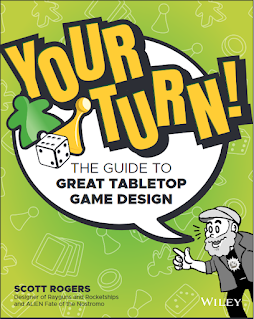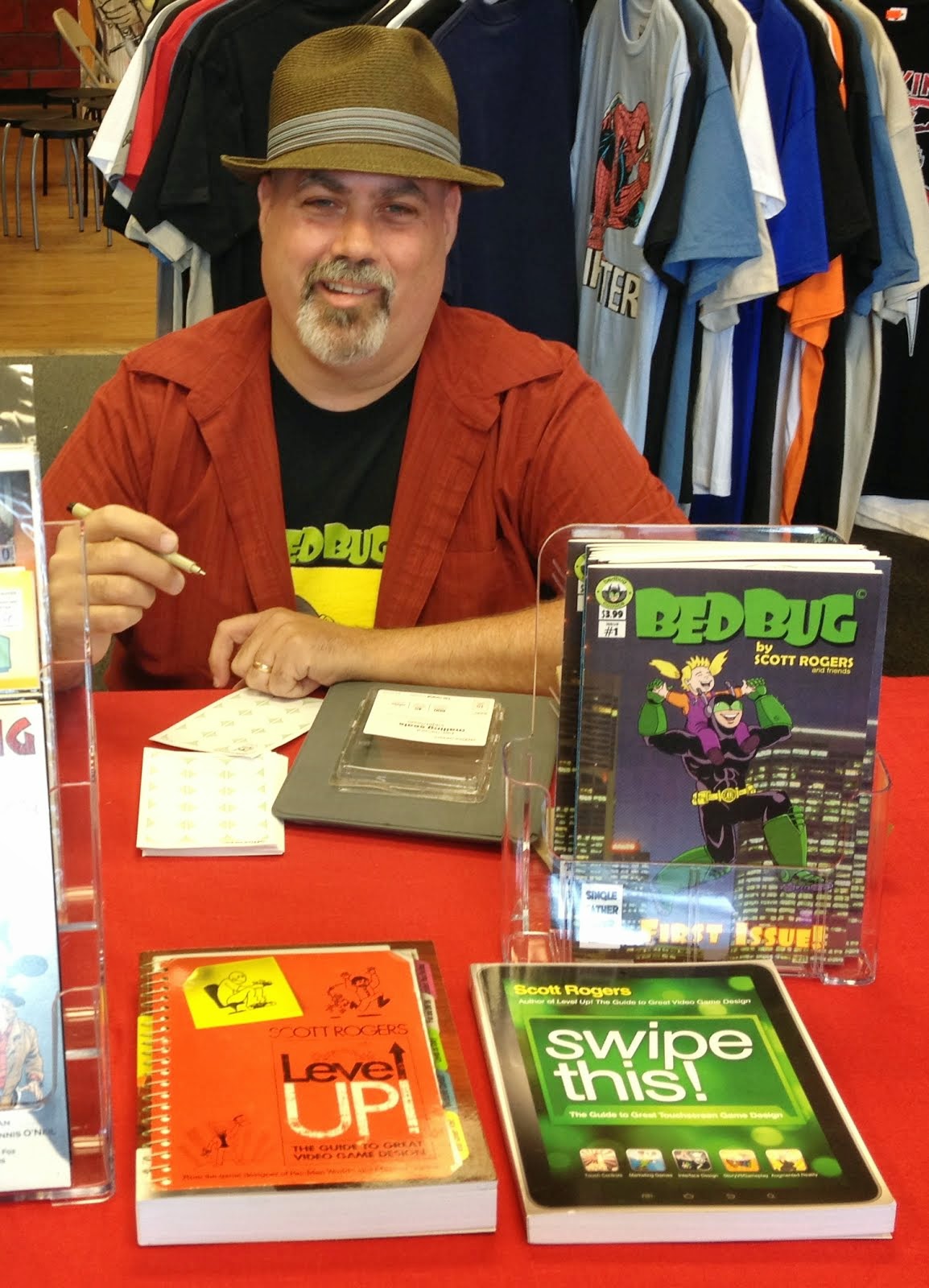 |
| I wish this were my set-up, but I borrowed the image from online |
This past week, I've been experimenting with different types of games that I think are best played over video conferencing systems (I have a list of recommendations here). As a game designer, I've been interested in discovering what factors that make for a good and bad game to be played over video conferencing. With the help of my Systems Literacy class at the New York Film Academy (hi guys!), here are some guidelines to making games for video conferencing so far. I'm sure there will be more discoveries in the coming weeks and months...
ISSUES when designing remote games
Here were the issues we found when playing remote games.
Here were the issues we found when playing remote games.
- Rule books. Players might not have access to the rules or not have them easily in front of them. The other players could use a digital version of the rules, but I find juggling between a digital rulebook and the video of your players to be cumbersome. Either play a game "light on rules" (Werewolf, Qwixx, etc.) or use a physical print-out of the rules seems to be the best solution.
- Lack of visual feedback. Players will have a hard time seeing cards, dice, miniatures, due to the limited view. They might have a hard time comprehending what is happening during the game because of it.
- Limited view of game board. I have found that a single camera doesn’t show all of the angles of the game board. In a perfect set-up there would be at least two cameras - one for the board and components and the other on the face of the player. If you can set up a top-down camera (as seen in the image above) that's great, but the other players will still be missing out on seeing what their opponent is doing. This set-up works much better for cooperative games where one player is "operating" the game (like Pandemic or Fearsome Floors) than it does for competitive ones.
- Physicality. If players don’t have access to components, how will they roll dice, move pawn, etc.? We experimented with a few games that use components to see how they played. Admittedly, we had too many players for that King of Tokyo game we played, but players reported feeling disassociated from the game because they couldn't roll the dice, couldn't handle the energy cubes, didn't have a good look at the cards. They missed the satisfaction of rolling the dice for themselves. When I asked them (they are all college students) what made this different than watching a "let's play" video on Youtube or Twitch, they replied "we're supposed to be playing the game and because you were doing everything for us, it didn't feel like we were playing the game." A fair point. We tried again with a game where everyone (almost everyone) had their own dice - Farkle aka Bupkiss - but the game progressed so slowly, that it was again unsatisfying to the players. Once again, the player count might have made a difference there - we had 12. But even with their own dice, they still complained about the speed and the immersion in the game. They had played it in a class room setting earlier in the year so they knew the difference between how the game felt "in person" and remotely.
- Components. When we played King of Tokyo, the lack of physical components contributed to lack of immersion. The Game ended up relying heavily on verbal input (or chat) than those from the other senses. The conclusion was that unless the game was "word" or "verbally"-centric, it was inferior over video conferencing. (As I am one who prefers the scientific method, I am going to continue testing this with a smaller sample size of players - who wants to join me?)
- Secret info. Keeping track of personal or secret information like cards is tricky - without a secondary camera (like on a phone) this might be even harder. This is where the "two-sets of games" solution could come into play. This is where both players have the same game and use the same parts to play the game - much like Chess or Diplomacy by mail used to be played. I have yet to test this out IRL.
- Cheating. Easier for a player to cheat if other players cannot clearly see them. Fortunately, the solution is "don't cheat."
- Turn Order. Turn order is less intuitive – especially since “clockwise” is such a common conceit in games. This is fine for two-player games, but anything more than three and it starts to become a juggling act. I wonder if games with a fluid turn order might be the solution here. Need to do more investigating... Post game suggestions in the comments.
- Stats. Players will have difficulty tracking stats. This one I need to do more testing with. I think that games with "common and shared information" - like Qwixx, Bingo, Karuba, Dixit, etc. - might play better over video conferencing than games that require more individualized information.
- Table Talk. Players miss out on “table talk”. Granted, my students were very polite and none of them interrupted me while we were playing, however even though I encouraged them to engage in table talk, it was still limited and not as robust as it was in person. I think part of this is the culture of phone/video conferencing conversation - people are just used to letting other people have their say before saying something. Which is in contrast to the more boisterous conversations that happen in person.
- "Alpha Gamer". The video format can unintentionally cause “Alpha Gaming” to happen. "Alpha Gaming" is the phenomena when one player takes charge of the game and instructs the other players on how to play the game. By the nature of me "being in charge" of the game, I found that the other players deferred to me (it might have been also because I was the teacher) and I ended up doing most of the talking. I think this might change if I were playing with my regular gaming group or if each player had access to their own copy of the game.
- Urgency. Some of my student players said that they missed out on player agency, engagement and urgency. By not being in control of their own pieces, they didn't feel like they "belonged" to them and therefore they didn't care as much what happened during the game. They felt detached and felt like the game didn't matter. This disassociation is to be expected as the players are merely "ghosts" in relationship to the physical game.
SOLUTIONS to designing remote games
Here were a few of the solutions that were determined based on the play tests.
Here were a few of the solutions that were determined based on the play tests.
- Design to the format: Since remote gaming utilizes a camera and a mic, design something that uses its strengths. Games that have strong visuals, sound or discussion in the game play work much better than cards, dice and components. Your tools are a camera, microphone as well as your player’s voice, facial expressions and gestures.
- Compensate: Designers might have to make rules that compensate for these deficiencies, but be careful, the solution might create as many issues as the problem. This happened when we were playing King of Tokyo. Because we had so many players, we added a rule that the first time a player died, they reset their health. Many of the students reported that this would be "hard" to keep track of. Granted, this is not the way the game was meant to be played, but rather than having a half-dozen students knocked out of the game early on, it seemed like a fair compromise. Whether it was a good design change, I am still considering...
- Camera Set-Up: Unfortunately, most of us don't have a multi-camera set-up.Make sure your camera set-up shows the important most thing in the game – for example, if you are playing a dice game, make sure the players can see the dice. In a strategic board game like Pandemic, show the board.
- Breakout Rooms and Chat: Don't forget to use chat and breakout room for game play. These are both great for public as well as secret knowledge.
- Use Online tools: There are lots of apps and browser based dice rolling programs. Many games have digital versions that can supplement or replace your physical copies.
- Camera Set-up: The best way to play many board games via video conferencing is to have a multi-camera set-up. This way players can see the board, their tableau or hand of cards and the other player's face. However, this can be expensive as you need multiple cameras and/or computers to run them and if you aren't tech-savvy, it can be tricky to set up. When setting up your cameras, think about what the player needs to see the most during the game. Make your primary camera focused on whatever that is. An alternative is to place each player's pieces or tableau on their own separate tray or board (some stiff cardboard works just fine) and bring them in and out as it is each player's turn.
- The Moderator is there to help: If you game has a board with components like resources or miniatures or unique dice that cannot be replicated with an online roller, the host of the Zoom meeting should "run the game" and act as the player's hands. As moderator, you have control over other functions like muting players, turning off their video, sending private chat messages and sending players to and from breakout rooms. Use these tools to help run your game. It will go a bit slower, but it will eventually make things run smoother.









1 comment:
Good stuff. I'm playing with a game idea that asks player to provide a couple of dice (or roll a couple on random.org) and some pawns to track the current state of the game (this would be a common board if played IRL, but via video, everyone needs to see it / track it, so it's easier to enable it on a single A4 sheet).
It's still very much playable in real life, too... Or so the design will hopefully go, once I can get it to a table for playtesting.
Post a Comment